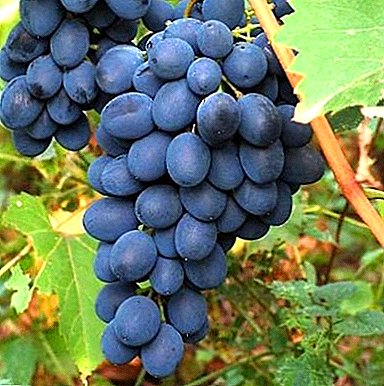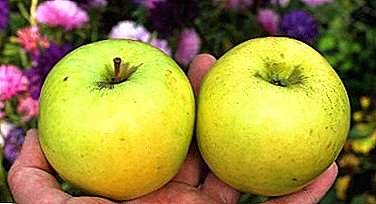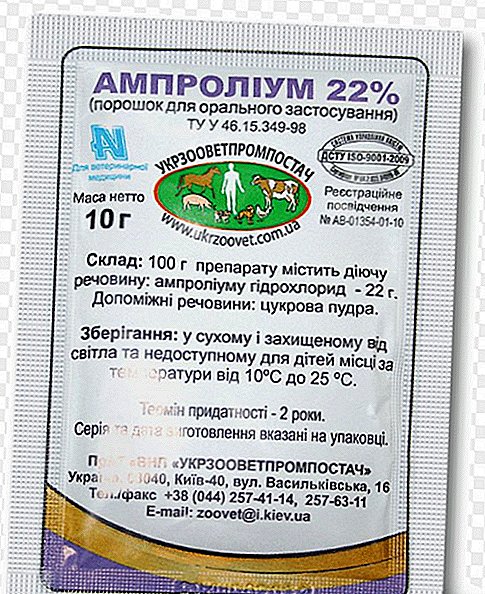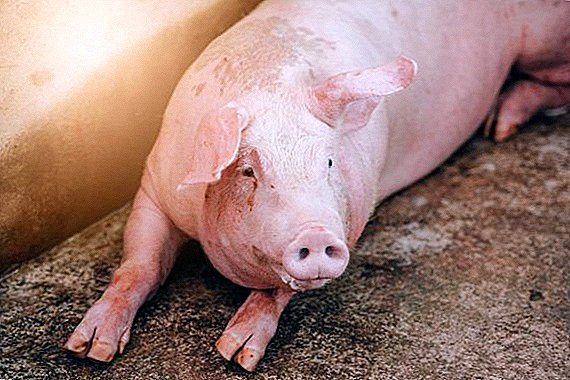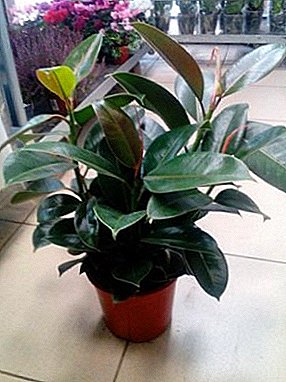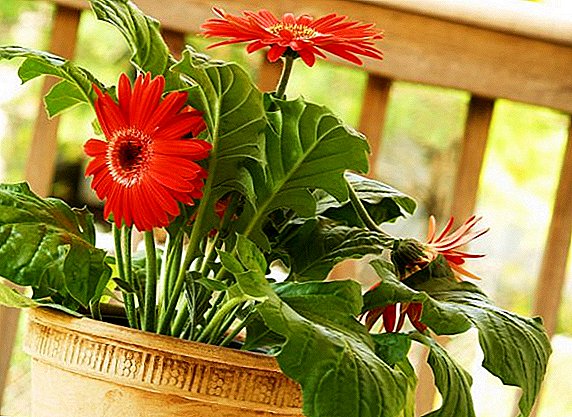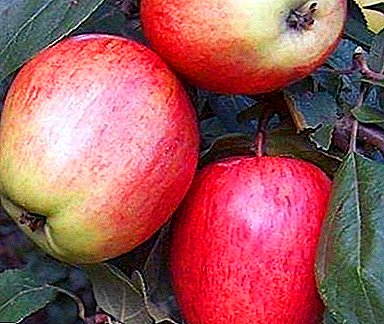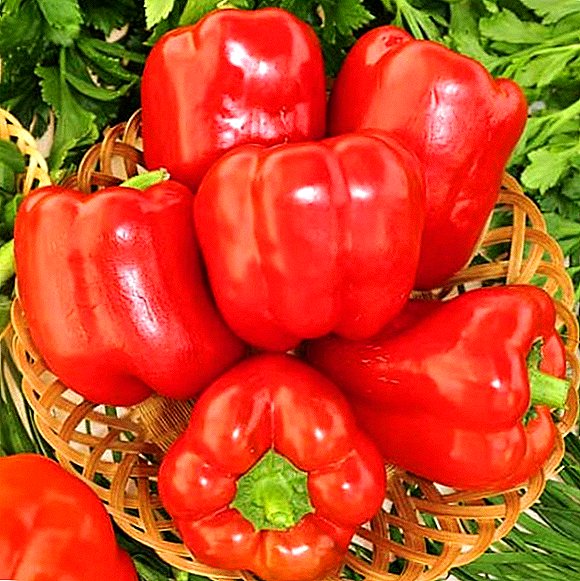 Today there is a large selection of varieties of sweet peppers, which have attractive characteristics for summer residents and gardeners. Among them is a hybrid variety "Flamenco f1". This article will tell in detail about this vegetable crop and its agricultural cultivation.
Today there is a large selection of varieties of sweet peppers, which have attractive characteristics for summer residents and gardeners. Among them is a hybrid variety "Flamenco f1". This article will tell in detail about this vegetable crop and its agricultural cultivation.
Hybrid description
Flamenco sweet pepper is an early hybrid based on cubical red bell pepper. Next, we describe the appearance of the vegetable culture and its fruits.
Bushes
The hybrid is powerful, with strong stems, erect and sprawling bushes, from half a meter to 1 meter in height (depending on the conditions of their cultivation).
Important! Bulgarian pepper is in the "black list" of vegetables, which most often producers process with pesticides.

Fruit
The fruits of the Flamenco peppers are compact on the bushes and have the following characteristics:
- drooping
- 3-4-chamber,
- have a cuboid or prism shape;
- during technical ripeness - green-yellow color;
- in the phase of biological maturity - saturated red;
- the average weight of one fruit is 160-180 g, sometimes it reaches 400 g;
- compact seed chamber;
- juicy pulp;
- wall thickness - from 6.5 mm to 9 mm;
- the size of an average pepper is 10-15 cm;
- fruits with a characteristic aroma and sweet taste, without bitterness.
Other characteristics
Now consider the other additional characteristics of the hybrid. 
Resistance to environmental conditions and diseases
Vegetable culture is resistant to adverse and stressful environmental conditions, under which the formation of shrubs and ovaries is possible.
Check out the nuances of cultivating such varieties of sweet peppers like Gypsy F1, California Miracle, Ratunda, Orange Miracle, Claudio, Soloist, Anastasia, Cowhide, Kakadu, "Atlant", "Bogatyr", "Belozerka", "Swallow", "Gogoshar".
For example:
- Plants feel quite well at + 14 ° C.
- The most optimal temperature indicator for the growth and development of culture in open ground is + 20 ° C.
- When the temperature indicator is below 13 ° C, it is better to keep the culture under the film or in the warmth.
Paprika "Flamenco" has resistance to the following diseases:
- Potato viruses.
- Tobacco mosaic virus.

Learn more about the beneficial properties of Bulgarian pepper.
Gestation period
The variety "Flamenco f1" is early ripening, because the time from first sprouts to fruit ripening is on average 95 days, or 65 days from the moment the seedlings are planted.
Yield
Flamenco peppers bear fruit until late autumn and are famous for good harvests: on average, up to 8 kilograms of pepper are harvested from one square meter of open ground, and up to 13 kg in warm teas. From one bush on average you can remove up to 8 fruits.
Important! It is important to pick ripe peppers in time: regularly harvesting, you stimulate the plant to form new fruits.

Direction
Thanks to the healthy composition of flamenco sweet pepper, excellent taste, juiciness and bright color, it can be used fresh, canned, and also prepare many dishes, combining almost with any products.
Here are a few dishes that can be cooked with Flamenco peppers:
- different variations of salads, where fruits are added;
- first courses (borscht, soups);
- various snacks with baked peppers (warm salads);
- saute with chicken, mushrooms and zucchini;
- rice with sweet pepper;
- vegetable stew;
- stuffing with any fillings;
- cream of pepper, cauliflower and cheese;
- canned pepper for the winter in tomato sauce (lecho) or marinade;
- various dishes with baking in the oven (ratatouille);
- desserts (panna cotta);
- homemade bread with paprika;
- pies with various fillings;
- kurnik;
- kulebyaka;
- jellied pies;
- omelette;
- other dishes.

We recommend reading about how to prepare fried and pickled peppers for the winter.
Growing seedlings, timing, seed preparation, seedling care
Flamenco vegetable hybrid is grown using a rassadnogo method. Next, tell about the intricacies of its cultivation.
Optimal timing
Seedlings of early Flamenco peppers are planted in the open ground in the last decade of May, after 45 days from the time of sowing the seeds.
Did you know? For the first time, a seasoning of ground pepper, called "paprika", was brought by Columbus from the South American continent. Navigator himself called it "Indian Red Salt".
Soil mix
High-quality soil for planting a hybrid "Flamenco" directly affects the friendly germination of planting material and the proper development of seedlings. The soil should be loose, well absorbing water. 
Acceptable soil mixture for sowing seeds of peppers should consist of such ingredients:
- light brown peat with fully decomposed vegetation residues;
- turf soil;
- sawdust;
- coarse sand;
- perlite;
- humus;
- garden compost;
- biohumus;
- coconut substrate.
Two options for the proportion of the composition of the soil:
- Peat, humus, turf (with the addition of river sand) - 5: 1: 4.
- Turf soil, peat, compost (1: 3: 1) with the addition of mineral fertilizers (per kilogram of soil: 1 g of ammonium nitrate + 10 g of superphosphate + 5 g of potash salt).
Video: preparing the soil for the seedlings of peppers Important additional tips:
- After combining all the ingredients of the planting mixture, the soil should be shed with a light solution of potassium permanganate in order to disinfect it.
- To keep the moisture in the ground with the seedlings longer, a hydrogel is added to the earthen mixture, soaking it in advance with water.
Growing tank
Pepper seedlings can be grown in such containers:
- boxes,
- plastic jars and cups,
- cells,
- peat tablets,
- small flower pots.

Important! In spite of its beneficial properties, sweet pepper has some contraindications: stomach ailments in exacerbations, hemorrhoids, severe damage to the liver and kidneys, as well as hypotension.
Seed preparation
To paprika seeds had high germination, you can spend the following steps (one to choose from):
- Selection of quality seeds - Prepare 3% saline solution (30 g of salt per 1 liter of water), pour out pepper seeds, mix and leave for 5-7 minutes. Full seeds should sink to the bottom of the dish, and empty to emerge. Then the solution with the emerged seeds need to be drained, rinse full seeds, spread on paper and allow to dry.

Did you know? Chocolate and sweet pepper have common properties: they are capable of throwing "hormones of happiness" or endorphins into the blood. Given the high calorie content of chocolate, it is more profitable for the figure to “happy" yourself with the help of pepper.
- Etching - immerse the seeds for 15 minutes in a light solution of potassium permanganate, and then wash and dry.

- Micronutrient saturation - put the seeds in canvas bags, immersed in a solution with trace elements and leave for a day. After getting them out of the solution and dry. No need to wash. This procedure is carried out the day before sowing seeds.
- Moisturizing and germination - put the pickled seeds in a canvas cloth or gauze moistened with water and put in a warm place. In a day they will germinate, and they will need to be sown immediately in wet soil.

- Hardening - soaked in potassium permanganate seeds soaked in warm water before swelling, and then place the dishes with seeds in a cold place at a temperature of + 1-2 ° C for a day. Then the water needs to be drained and the seeds dried (not in direct sunlight).
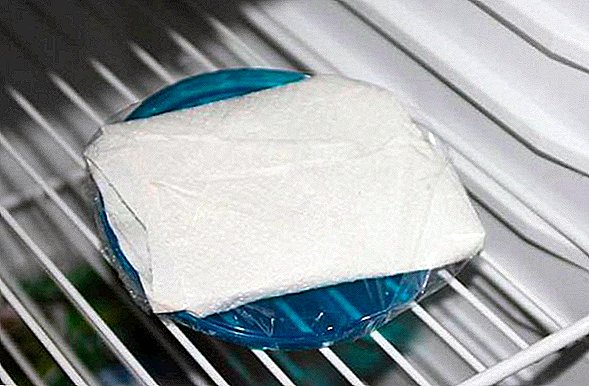
Sowing seeds
Flamenco hybrid pepper seeds should be sown at the end of February. We emphasize that of all the above options for tanks for sowing seeds, the peat tablet is considered the most convenient, since it is easy to transfer a seedling during a transplant without making a dive, which the peppers do not tolerate well.
If you use wooden boxes, plastic cups or cells for this, then your following actions should be as follows:
- Tanks should be filled with soil mixture, not reaching the top 2 centimeters, and moisten the mixture.
- Grooves are made in the boxes for sowing seeds with a depth of 1 cm and an intermediate distance of 5 cm.
- Sow the seeds in boxes need at a distance of 2 cm from each other, after which the grooves with seeds need to sprinkle a small amount of soil.
- Cover the box with plastic or glass on top to reduce evaporation of moisture.
- A week later, the seeds should ascend, after which the glass or polyethylene must be removed so that the seedlings do not overheat.
Video: Sowing Pepper Seeds
You will probably be interested to know when the best time for sowing pepper to seedlings is, the best way to feed pepper seedlings, how to grow quality seedlings, and what to do when the leaves of pepper seedlings turn yellow and fall.
Seedling care
Further care of the sweet pepper seedlings is as follows:
- Appropriate place. Tanks with sown seeds should stand on a warm window sill or near the battery.
- Moisture. Every day you need to check the soil in the containers for the presence of moisture. It is necessary to water the seedlings with warm water with a temperature of + 28-30 ° С, not allowing the overmoistening of the soil.
- Sufficient illumination. It is possible to provide the seedlings with the optimum amount of light by connecting LED or fluorescent lamps from 7 am to 9 pm.
- Optimum temperature. The daytime temperature should not exceed + 25-28 ° С, and the night temperature - + 22-24 ° С.
- Top dressing. Once every two weeks the seedlings need to be fed with a finished liquid organic top dressing. For this fit: "Fortress", "Agricola", "Mortar", "Lux", "Fertika".
- Air humidity. Ventilate the room regularly, avoiding drafts, and spray the plants with a spray bottle.

Hardening seedlings
14 days prior to planting seedlings in open ground, they should be gradually accustomed to temperatures from + 15 ° C, as well as to fresh air. Be sure to protect the seedlings from direct sunlight.
What can be done for hardening pepper seedlings:
- Happy to open a window or window.
- Expose seedlings to a ventilated veranda or balcony.
- Carry out in clear and calm weather.
- Gradually increase the residence time of seedlings in the open air, starting from 15 minutes a day.
We advise you to read about how to feed the pepper after planting in open ground, as well as how to feed the pepper with yeast.
Planting your own seedlings on a permanent place
By planting sweet pepper seedlings in open ground should be approached responsibly: adhering to the right time, choosing the right place and carrying out planting on the right technology.  Further growth and crop yield will depend on compliance with all these requirements. Now we will stop on each requirement separately.
Further growth and crop yield will depend on compliance with all these requirements. Now we will stop on each requirement separately.
Timing
Terms of planting seedlings in open ground and other subtleties:
- Approximately on the 45th day after sowing of seeds and germination of seedlings, seedlings should be planted in open ground.
- By this time, pepper bushes should have from 8 to 12 leaves.
- The average daytime temperature during the day should be at the level of + 15-17 ° С, and the nighttime temperature should be + 10-12 ° С.
- Usually, constant temperatures are set after the last May frosts - from May 10 to 30. This period is considered the most appropriate, since during this period there is no longer a threat of spring frosts, and there will be enough time for the crop to ripen in August-September.
- Despite the positive temperature, at first it is necessary to cover the seedlings with foil.
- If the seedlings are intended for planting in the greenhouse, then they are planted a little earlier - from 1 to 15 May.

Choosing a place on the site
The quality and quantity of the crop directly depends on the placement of the bushes of sweet pepper on the plot.
Culture location requirements:
- The site should be well warmed and illuminated by the sun.
- The place should not be blown by the wind.
- It is unacceptable to plant crops in wet and lowland areas.
- Unsuitable areas with acidic, sandy and clay soils.
Good forerunners for him are:
- cucumbers,
- green crops
- courgettes,
- bow,
- legumes,
- early cabbage.

It is not recommended to use the place where solanaceous crops (bell peppers, tomatoes, potatoes, chilli peppers, physalis, eggplants) were grown before, as it may contain pathogens of diseases of these crops.
Scheme and depth of landing
The landing pattern and its depth should be as follows:
- Before planting seedlings, on the plot you need to make a layout of rows and prepare the holes.
- Considering the fact that the bushes at Flamenco are tall, you need to leave a distance of 60 centimeters between each bush so that the plants do not stifle the growth of each other.
- The same distance should be between the rows.
- The wells are prepared with a depth slightly greater than the height of the seedling container.
Video: planting pepper in open ground There is another way to grow lettuce - square-nesting: seedlings of two shrubs are located at the same distance from each other (60x60 cm).
Care Tips
As with any vegetable crop, for Flamenco pepper we need the right arrangements for caring for it:
- Watering.
- Weeding
- Loosening the soil.
- Tying up
- Timely dressing.
Watering
Water culture is not often, as the soil dries.
Important! Water for irrigation of peppers must be separated and heated to +35°C. If the plants are watered with cold water, the flowers may fall off, and the plants will stop growing.
 Watering of the pepper bushes should be carried out according to the following system:
Watering of the pepper bushes should be carried out according to the following system:
- For the first time the culture is watered during its direct planting, while moistening the well under the planting, and not the plant itself.
- After 5 days, watering under the root is repeated.
- A further usual irrigation mode (in the absence of frequent rains) is every 7-10 days. This frequency of irrigation should be maintained until the first fruiting.
- During the massive collection of peppers in the watering is a break.
- Regular irrigation resumes with the arrival of the next period of flowering bushes.
We advise you to read about how to properly water the peppers in the greenhouse.
Soil care
Proper care of the soil, which includes loosening, creates favorable conditions for the development of culture, namely:
- Allow culture to grow faster.
- Provides air exchange for the roots.
- Increase the activity of beneficial microorganisms.
- Rid of weeds.

When loosening the soil under a crop, it is important to remember some aspects:
- In the first 14 days after planting, loosening is not desirable, because in this period the roots of plants begin to harden.
- The first time you need to loosen the soil to a depth of no more than 10 cm.
- Subsequent loosening should be done after each watering and rain.
- A sign of when you need to loosen the soil - a little dried up soil without a crust.
Soil mulching is another stage in the care of plants. For the first time they produce mulching during persistent positive temperatures, when the earth is already warm enough. Mulch from straw or chopped weeds is poured under the bushes and in the aisle with a layer of 5 centimeters thick.
Learn more about why soil mulching is needed.
Video: why and how to mulch the soil Around the stems need to leave space for air circulation, otherwise the root neck will rot, and fungus can develop on plants.
This procedure has the following advantages:
- Preservation of soil moisture.
- Weed reduction.
- Lack of overheating and drying of the soil under the bushes.
- Improving soil fertility.
Top dressing
For normal growth and the formation of a good harvest of flamenco sweet pepper, its timely feeding with the correct composition of fertilizers is necessary.
When applying fertilizers, it is important to observe the following recommendations:
- For the first time, pepper dressing should be made 14 days after planting at a permanent growing place. Fertilizer can be urea or poultry manure diluted in water (1:20). Under each bush you need to pour one or two liters of the solution.
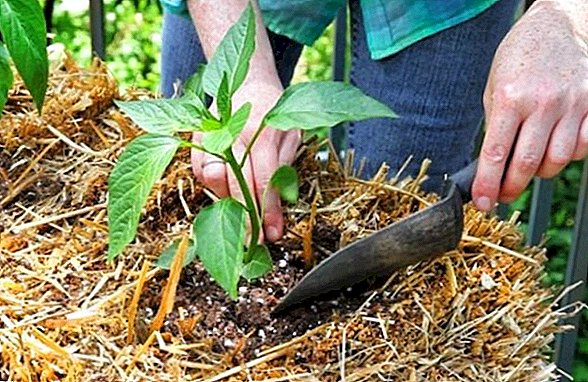
- The second dressing is done during fruit set. You can use an aqueous solution of mullein (1:10). After such feeding, beds are sprinkled on top of wood ash.
- The third time the culture is fertilized after the onset of fruiting. The same bird droppings solution will do as in the first case.
Garter
To prevent the tall bushes of the Flamenco hybrid from touching them, do not break, and also do not fall under the weight of fruits, it is advisable to tie them to supports. For this purpose, you can use stakes that are installed near each plant.
You can also tie up the bushes to the trellis of twine, stretched between the pillars, dug at both ends of the row. Not only the plant itself is tied up to them, but also overgrown branches. 
Advantages and disadvantages
Flamenco hybrid pepper has many advantages and almost no flaws.
Advantages:
- Fruits of high taste.
- The hybrid is resistant to diseases and viruses.
- Suitable for transportation, and for a long time has a presentation.
- After harvesting is stored for a long time and does not lose juiciness.
- Can be grown both in greenhouses and in the open field.
- Recommended for fresh consumption and for processing.
Disadvantages:
- The hybrid is sensitive to temperatures below + 13 ° C.
- In hot air (above + 35 ° C) flowers may fall off.
- Without support in the garden bushes can break under a large number of fruits.

Considering the above, about the Flamenco pepper hybrid variety, we can conclude that this is a suitable in all respects garden crop for growing in our open spaces, which significantly enriches our diet with vitamin dishes and various pickles. Observing all the rules of agricultural cultivation, you can get a generous harvest on your site.








